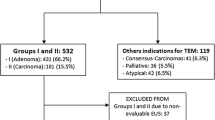Abstract
PURPOSE: Although preoperative evaluation of early rectal cancers can be done by endoluminal sonography and by means of colonoscopic findings, it is still controversial whether endoluminal sonography can effectively discriminate mucosal from submucosal lesions. This study was performed to verify objective causes of errors in the evaluation of early rectal cancer (T0/1) using a review of videotaped endoluminal sonography images. METHODS: Eighty-nine patients with suspected early rectal cancer on endoluminal sonography were included. Two different scanners with appropriate probes were used according to tumor location,i.e., transrectal ultrasonography was used to scan up to 8 cm of the rectum above the anal verge, whereas endoscopic ultrasonography was used to assess higher lesions. Endoluminal sonography images were correlated with histologic infiltration and were reevaluated carefully to identify sources of errors. RESULTS: Sensitivity and specificity were 83.1 and 96.5 percent, respectively, for tumor staging, whereas sensitivity was very low compared with specificity (16.7vs. 90.2 percent) for metastatic lymph nodes. Endoluminal sonography images showed irregularity of the underlying tumor border (P<0.01) and hypoechoic blurring or cutoff of the inner and outer hypoechoic layers (P<0.001), all of which closely correlated with histologic infiltration of tumor cells. Overstaging occurred more than twice as often as understanding in tumor reevaluation (14vs. 5 occurrences). In contrast to tumors, lymph nodes showed a similar amount of both overstaging (four cases) and understanding (five cases). The sources of errors were summarized as five types: false instrumentation, interpretive errors, anatomic defects, imaging failure, and inevitable errors. CONCLUSIONS: Because false instrumentation, interpretive errors, and anatomic defects were considered preventable, 23 (82.1 percent) of the 28 errors might have been avoided. Therefore, a clear image by endoluminal sonography can effectively distinguish mucosal from submucosal lesions in early rectal cancer.
Similar content being viewed by others
References
Adams DR, Blatchford GJ, Lin KM, Ternent CA, Thorson AG, Christensen MA. Use of preoperative ultrasound staging for treatment of rectal cancer. Dis Colon Rectum 1999;42:159–66.
Steele G. Local excision of early rectal cancer. Hepatogastroenterology 1992;39:212–4.
Lee P, Oyama K, Homer L, Sullivan E. Effects of endorectal ultrasonography in the surgical management of rectal adenomas and carcinomas. Am J Surg 1999;177:388–91.
Sailer M, Leppert R, Kraemer M, Fuchs KH, Thiede A. The value of endorectal ultrasound in the assessment of adenomas, T1- and T2-carcinomas. Int J Colorectal Dis 1997;12:214–9.
Adams WJ, Wong WD. Endorectal ultrasonic detection of malignancy within rectal villous lesions. Dis Colon Rectum 1995;38:1093–6.
Mosnier H, Guivarc'h M, Meduri B, Fritsch J, Outters F. Endorectal sonography in the management of rectal villous tumours. Int J Colorectal Dis 1990;5:90–3.
Kruskal JB, Kane RA, Sentovitch SM, Longmaid HE. Pitfalls and sources of error in staging rectal cancer with endorectal US. Radiographics 1997;17:606–26.
Beynon J, Mortensen NJ, Foy DM, Channer JL, Virjee J, Goddard P. Pre-operative assessment of local invasion in rectal cancer: digital examination, endoluminal sonography or computed tomography? Br J Surg 1986;73:1015–7.
Hildebrandt U, Feifel G. Preoperative staging of rectal cancer by intrarectal ultrasound. Dis Colon Rectum 1985;28:42–6.
American Joint Committee on Cancer. AJCC cancer staging manual, 5th ed. Philadelphia: Lippincott-Raven, 1977.
O'Brien MJ, Winawer SJ, Zauber AG,et al. The National Polyp Study: patients and polyp characteristics associated with high-grade dysplasia in colorectal adenomas. Gastroenterology 1990;98:371–9.
Norton SA, Thomas MG. Staging of rectosigmoid neoplasia with colonoscopic endoluminal ultrasonography. Br J Surg 1999;86:942–6.
Meyenberger C, Huch Boni RA, Bertschinger P, Zala GF, Klotz HP, Krestin GP. Endoscopic ultrasound and endorectal magnetic resonance imaging: a prospective, comparative study for preoperative staging and follow-up of rectal cancer. Endoscopy 1995;27:469–79.
Kim NK, Kim MJ, Yun SH, Sohn SK, Min JS. Comparative study of transrectal ultrasonography, pelvic computerized tomography, and magnetic resonance imaging in preoperative staging of rectal cancer. Dis Colon Rectum 1999;42:770–5.
Drew PJ, Farouk R, Turnbull LW, Ward SC, Hartley JE, Monson JR. Preoperative magnetic resonance staging of rectal cancer with an endorectal coil and dynamic gadolinium enhancement. Br J Surg 1999;86:250–4.
Kruskal JB, Sentovitch SM, Kane RA. Staging of rectal cancer after polypectomy: usefulness of endorectal US. Radiology 1999;211:31–5.
Heneghan JP, Salem RR, Lange RC, Taylor KJ, Hammers LW. Transrectal sonography in staging rectal carcinoma: the role of grey-scale, color-flow, and Doppler imaging analysis. AJR Am J Roentgenol 1997;169:1247–52.
Strunk H, Heintz A, Frank K, Buess G, Braunstein S. Endosonographic staging of rectal tumors. Fortschr Rontgenstr 1990;153:373–8.
Spinelli P, Schiavo M, Meroni E,et al. Results of EUS in detecting perirectal lymph node metastases of rectal cancer: the pathologist makes the difference. Gastrointest Endosc 1999;49:754–8.
Katsura Y, Yamada K, Ishizawa T, Yoshinaka H, Shimazu H. Endorectal ultrasonography for the assessment of wall invasion and lymph node metastasis in rectal cancer. Dis Colon Rectum 1992;35:362–8.
Sunouchi K, Sakaguchi M, Higuchi Y, Namiki K, Muto T. Limitation of endorectal ultrasonography: what does a low echoic lesion more than 5 mm in size correspond to histologically? Dis Colon Rectum 1998;41:761–4.
Huddy SP, Husband EM, Cook MG, Gibbs NM, Marks CG, Heald RJ. Lymph node metastases in early rectal cancer. Br J Surg 1993;80:1457–8.
Brodsky JT, Richard GK, Cohen AM, Minsky BD. Variables correlated with the risk of lymph node metastasis in early rectal cancer. Cancer 1992;69:322–6.
Boubein LD, David C, DuBrow R,et al. Endoscopic ultrasonography in staging rectal cancer. Am J Gastroenterol 1990;85:1391–4.
Bleday R. Local excision of rectal cancer. World J Surg 1997;21:706–14.
Mentges B, Buess G, Schafer D, Manncke K, Becker HD. Local therapy of rectal tumors. Dis Colon Rectum 1996;39:886–92.
Author information
Authors and Affiliations
About this article
Cite this article
Kim, J.C., Yu, C.S., Jung, H.Y. et al. Source of errors in the evaluation of early rectal cancer by endoluminal ultrasonography. Dis Colon Rectum 44, 1302–1309 (2001). https://doi.org/10.1007/BF02234788
Issue Date:
DOI: https://doi.org/10.1007/BF02234788




